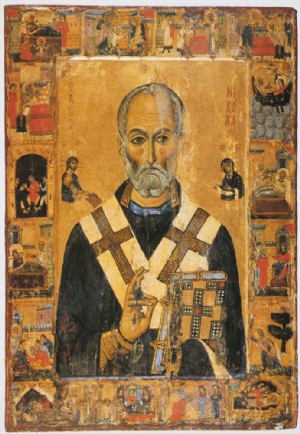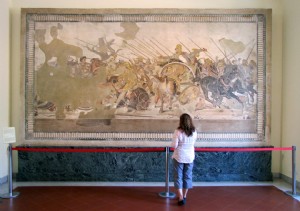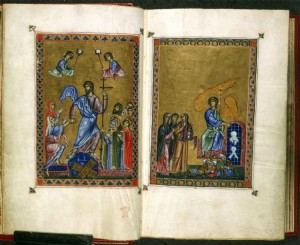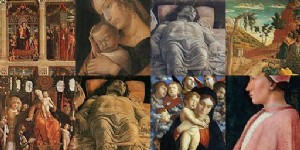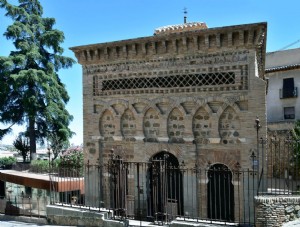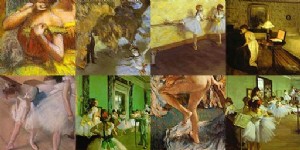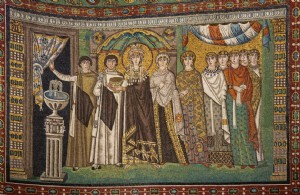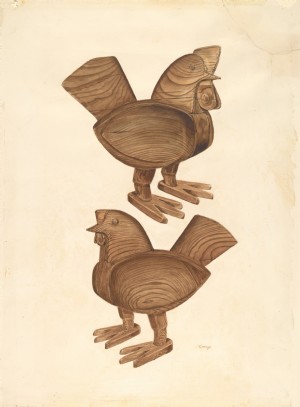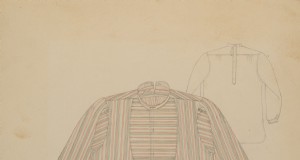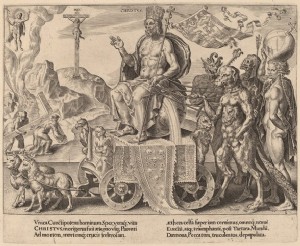티치아노 베첼리오 다 카도레(Titian Vecellio da Cadore)는 역사상 가장 위대한 예술가 중 한 명입니다. Leonardo와 같은 이탈리아 르네상스의 전설과 함께, 미켈란젤로와 라파엘로. 티치아노, 당대의 인정받은 천재, 그는 "화가의 왕이자 왕의 화가"라고 불렸다. 미술 분야에서 이 회화의 거물이 발견한 것은, 어떤 식으로든, 모든 후속 예술가의 작품에 영향을 미쳤습니다. 티치아노는 신화 장르의 발전에 큰 역할을 했으며, 풍경과 초상화. 그런데, 대가의 붓으로 포착한 것은 동시대인에게 최고의 상이었다.
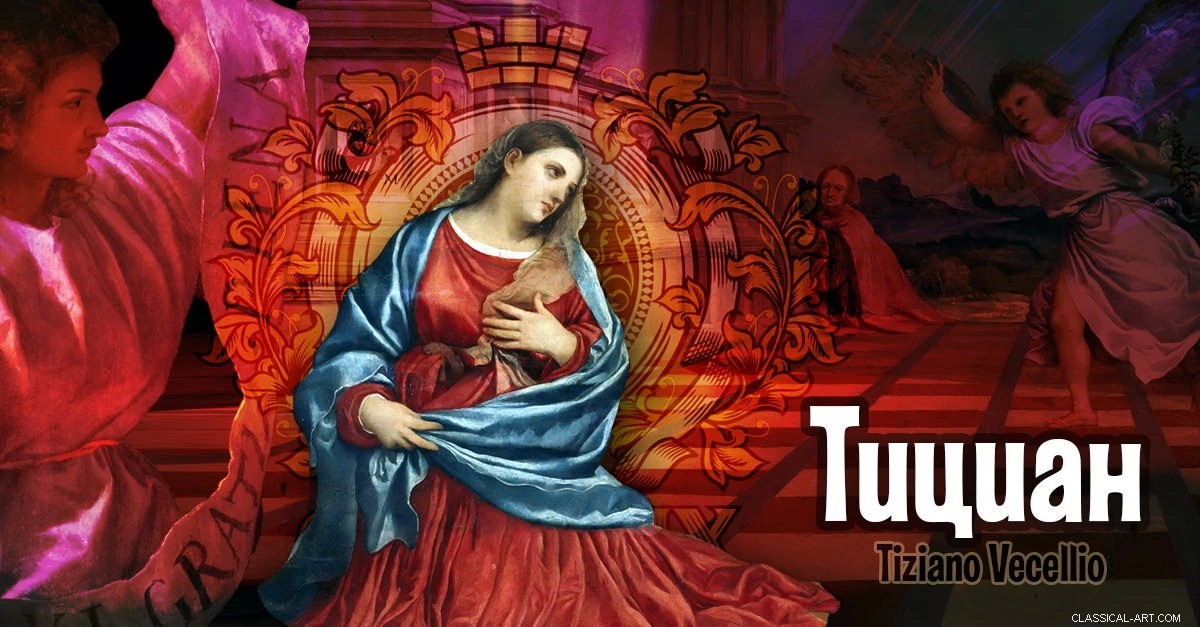
Titian – Gallerix.ru의 그림 갤러리
예술가는 오래 살았다. 그의 마지막 날까지 생각의 명료함을 유지하고, 지각의 감도, 시력과 놀라운 작업 능력. 이로써 티치아노는 생이 끝날 때까지 붓을 손에서 놓지 않고 후손에게 광범위한 예술적 유산을 남길 수 있었습니다. 그의 작품에는 허약함과 엄숙함, 영성과 현실의 일상성, 인간과 세계의 비극과 아름다움이 놀라운 방식으로 결합되었습니다. 이유없이, 화가의 작품은 수없이 복사되었습니다.
예술가의 삶과 작품은 베니스의 최고 번영기에 떨어졌으며, 그 권세와 영광의 광채, 글로벌 변화와 역사적 사건의 시간. 다양한 출처에 따르면, Titian은 1477년 또는 1480년에 태어났습니다. 그의 부모는 Pieve di Calore라는 작은 마을에 살았던 오래된 가족에 속해 있었습니다. 알프스에 위치. 소년은 일찍 그림을 그리는 능력을 보여 10살 때 부모가 그를 베니스로 보내 공부하게 했습니다. 조반니 벨리니의 공방에서 파악한 젊은 티치아노 순수미술의 토대, 젊은 예술가의 운명에 중요한 역할을 한, 이미 유명한 화가인 조르조를 소개합니다. 이 만남은 티치아노의 삶에 큰 역할을 했고, 덕분에 일찍 자신만의 스타일을 찾아 인정을 받았다. 그리고 재능있는 두 예술가는 친구가되지 않았지만 습관, 등장인물과 인생관이 너무 달랐습니다. 조르조네가 티치아노의 삶에서 수행한 역할을 과소평가할 수 없습니다. 그의 연장자 동지에 대한 후자의 존경은 티치아노가 조르조네의 예상치 못한 죽음을 얼마나 힘들게 겪었는지에 대한 생존 증거로 판단할 수 있습니다(위대한 예술가는 그가 겨우 35세였을 때 예기치 않게 사망했습니다).
조르조네의 재능과 그가 티치아노의 운명에서 한 중요한 역할에 대한 독특한 찬사는 조르조네의 잠자는 비너스의 예술가가 복원한 것입니다. 불에 타버린 것. 티치아노는 돌이킬 수 없는 화재로 손상된 캔버스를 완전히 다시 썼고, 여주인공의 포즈와 그녀의 부드러운 얼굴 만 유지합니다. 겸손한 화가는 자신의 이름으로 그림에 서명하기 시작하지 않았으며 조르조네의 붓으로 인한 걸작의 거의 완전한 저자에 대해 언급하지 않았습니다. 아마도 이 작업은 뒤이은 혼란의 첫 번째 이정표였을 것입니다. 그로 인해, 수십 년 동안, 티치아노의 그림, 보기 드문 완벽한 실행으로 구별되며, 종종 조르조네의 붓에 기인했습니다.
하지만 조금 돌아가자, 즉, 1508년, 이탈리아 르네상스의 "황금기" 동안, 인정받은 예술가가 젊은 티치아노를 초대하여 베니스에서 독일 화합물을 장식하는 데 도움을 청했을 때. 조르조네는 그의 젊은 동지보다 훨씬 일찍 독일 컴파운드의 일부를 설계하기 시작했습니다. 더 유리해 보이는 건물의 주요 정면을 스스로 선택합니다. 티치아노는 좁은 거리가 내려다보이는 안뜰의 뒷편으로 남겨졌고, 항상 사람들로 가득했던 곳. 조르조네, 그는 재능 있는 화가일 뿐만 아니라, 매력적인 남자이기도 하지만, 그는 항상 그의 작업장에 와서 예술가를 칭찬하고 그의 창작 정신을 키우는 많은 친구들에게 둘러싸여있었습니다. 티치아노, 그의 침묵과 고립으로 구별되는, 주로 혼자 일했다. 당연하지, 성취감과 자신감이 더 높은 조르조네는 그의 젊은 동료보다 훨씬 일찍 일을 마쳤습니다.
독일군 복원이 마침내 완료되었을 때, 베니스 전체가 이 기적을 보기 위해 달려갔다. 관객의 기쁨은 끝이 없었고, 수많은 증언에 따르면, 티치아노의 그림은 가장 감각적이었습니다. 벽화를 평가하자면, 특별위원회가 만들어졌고, 벨리니가 이끄는 그날 그곳에 있었던 증인 중 한 사람인 돌체는 살아 남았습니다. 그녀는 무엇보다 칭찬입니다. 색감과 디자인이 너무 완벽해서 관객들 앞에 등장하자마자 조르조네의 모든 친구들, 만장일치로 이것이 그의 작품이라고 결정한 사람, 즉시 예술가를 축하하기 시작했습니다. 이것이 그의 모든 창조물 중 최고라는 것을 그에게 확신시켜 주었습니다. " 안타깝게도, 현재로서는 두 주인의 작품을 판단할 수 없다. 왜냐하면 불과 30, 40년 후에, 프레스코화는 습기로 인해 거의 완전히 사라졌습니다. 바다 소금으로 포화, 베네치아 공기, 녹슨 페인트. 하지만 살아남은 개별 파편들에서도 티치아노는 이 어려운 시험을 훌륭하게 통과한 것이 분명합니다. 깊이 있는 개성을 지닌 재능 있는 예술가로 스스로를 선언한다.
그리고 무게, 이번 프로젝트 참여 덕분에 아주 일찍부터 티치아노의 작품에 대해 이야기하기 시작했고, 거장의 첫 작품은 보기 드문 리얼리즘과 세심한 디테일 전달이 눈에 띄었기 때문에, 젊은 화가들에게는 거의 불가능한 일이었습니다. 예술가의 초기 인지도에서 최소한의 역할은 국가의 창조적 인 사람들에게 매우 유리한 상황에 의해 수행되었습니다. 이 기간 동안, 베니스는 평화와 번영, 강력한 함대 덕분에 발전된 무역과 강력한 경제적 지위.
독특한 스타일 만들기
시인의 시대였다. 작가, 음악가와 예술가들은 고요한 자연을 배경으로 행복한 사람들을 그렸습니다. 예술 작품의 주요 주제는 사랑이었습니다. 관계의 아름다움과 시. 그러한 환경에서, 젊은 티치아노의 창의적인 길이 시작되었습니다.
처음에는, 작가는 자연의 이미지에 사로잡혔고, 그리고 일몰 전의 마법의 시간, 하늘이 밝았을 때, 포화 된 색상, 그가 가장 좋아하는 시간이 되었다. 티치아노가 가장 좋아하는 계절은 가을이라고 짐작할 수 있습니다. 그 폭동과 여러 가지 빛깔의 색으로. 진실, 풍경에 대한 사랑은 오래가지 못했다. 시간이 지남에 따라 주인은 다른 장르를 선호하기 시작했고, 즉 초상화.
사람들은 예술가를 끌어들이기 시작했고, 그들의 풍부하고 복잡한 내면 세계와 함께. 작가의 초기 작품 중에는 "파란 소매 드레스를 입은 남자의 초상", 예술가의 가장 친한 친구 중 한 명을 묘사한 시인 루도비코 아리오스토, "TV" 이니셜 난간에 기대어, 특별한 기술로 눈에 띈다. 진실, Titian 자신이 그림에 묘사 된 버전이 있습니다. 현재 런던 내셔널 갤러리에 소장되어 있습니다. 이 질문은 여전히 논란의 여지가 있지만, 근본적인 것은 아니지만, 이 작품에서 가장 중요한 것은 그 대상이 아니기 때문에, 그러나 젊은 예술가의 글쓰기 방식과 그녀가 수행한 기술. 그림의 우아한 색감, 스트로크의 가벼움, 심플하고 조화로운 구성, 아름답게 칠해진 남자 옷의 천, 위에서 보는 사람을 조금 내려다보면서 이 모든 것이 Titian의 이미 뛰어난 재능의 특징입니다.
시간이 지남에 따라 티치아노의 작품은 그 어느 때보다 더 큰 이야기로 가득 차기 시작했고, 역학, 긴장과 드라마. 그들에 대한 본성은 더 이상 고요하고 정적이 아니었고, 그것은 생명으로 가득 차 있었고, 그리고 그 배경에 반대하는 사람들은 감정과 움직임으로 가득 차있었습니다. 예를 들어, 그림에서 인간의 세 시대(1512, 스코틀랜드 국립 미술관, 에든버러), 시간의 흐름과 인간 시대의 간결함을 보여준다. 그림의 줄거리, 햇살 가득한 풍경을 배경으로 펼쳐지는 오른쪽에서 왼쪽으로 읽어야 합니다. 두 아기, 오른쪽 전경에서 달콤한 잠을 자고, 사람이 미래에 어떤 기쁨과 슬픔이 그를 기다리고 있는지 아직 알지 못하는 고요한 삶의 시작을 묘사합니다. 작은 천사는 아이들의 평화와 안전을 지키고, 어린 풀이 겨우 지나갈 수 있는 곳. 구성의 왼쪽 부분에는 전경에서, 두꺼운 나무 면류관 아래, 사랑에 빠진 젊은 부부입니다. 그림의 이 부분은 우리가 젊었을 때 삶의 한가운데를 나타내고, 힘이 넘치는, 욕망, 건강과 에너지. 그리고 배경에는 두 개의 두개골을 손에 들고 있는 노인이 앉아 있습니다. 해골은 각자의 삶이 끝날 때마다 죽음의 필연성을 상징합니다. 노인의 머리는 가슴까지 내려오고, 노년의 슬픔과 절망을 표현합니다. 그림의 의미는 간단합니다. 우리 모두는 나중에 죽기 위해 태어났습니다. 이 주제는 그의 작업 전반에 걸쳐 Titian을 흥분시켰습니다. 다른 캔버스에 반영되어 예를 들어, “시간과 마음의 알레고리, "에 대해서는 나중에 고려할 것입니다.
그림 "컨트리 콘서트"(1510년경, 루브르 박물관, 파리)도 작가의 창작 초기에 속하며, Titian은 아름답고 조용한 저녁 시간에 자연과 인간의 놀랍도록 조화로운 융합을 전달했습니다. 여기 우리 앞에 옅은 녹색과 밝은 색의 아름다운 옷을 입은 두 젊은이가 있습니다. 레드 오렌지 색상. 그 중 한 명은 음악가이며, 그는 그의 류트의 현을 만지려고 하고, 다른 하나는 마을 사람이고, 그는 주의 깊게 들을 준비가 되어 있습니다. 전경에는 벌거 벗은 여자가 있고, 그녀의 손에 플루트, 아마도 이것은 Muse입니다. 그녀는 관객에게 등을 돌리고 음악가를 조심스럽게 바라보고 있습니다. 구성의 왼쪽에는 또 다른 벌거 벗은 처녀가 있습니다. 그녀의 손에는 물이 담긴 그릇이 있고, 예술과의 소통을 통해 모든 생물을 정화한다는 이념을 상징합니다. 자연을 배경으로 한 소녀들의 누드는 매우 조화롭게 보이며, 순결한 감정의 표현에 대한 중요한 알레고리이다.
배경으로 구성이 완성되고, 우리를 이 놀랍고 시적인 분위기에서 삶의 산문으로 되돌리고, 어디에서나 숨길 수 없는 것입니다. 양치기, 빽빽한 나무 면류관 아래에서 그의 무리와 함께 방황하고, 그림 속 지구의 의인화가 되었다. 그림의 깊이에서 당신은 단순한 농민 집의 지붕을 볼 수 있습니다. 그곳에 사는 사람들은 이 천상의 자연의 존재를 의심조차 하지 않습니다. 사진을 보시면, 영웅이 류트를 연주할 시간이 없었지만 음악의 매혹적인 소리는 이미 전체 공간을 채울 수있었습니다. 처음에는, 이 그림은 조르조네의 붓에 기인한 것으로, 꿈과 환상으로 가득 찬 이상적인 세계의 이미지라는 그의 방식에 매우 큰 영향을 미치기 때문에, 시간과 공간의 바깥에 존재한다.
고상한 것과 세속적인 것을 대조하는 주제는 티치아노의 다른 작품에 반영되어, 같은 기간에 속합니다. 그림 "중단된 연주회"(1510년경, 팔라조 피티, 피렌체), 열정적으로 스피넷을 연주하는 젊은 승려를 봅니다. 그의 뒤에는 그의 어깨를 만지면서 젊은이의 게임을 막으려는 노인이 있습니다. 수도사는 마지 못해 자신의 직업에서 벗어나고 있습니다. 그의 얇은 손가락은 계속해서 열쇠 위로 펄럭입니다. 그의 머리는 이미 옆으로 돌렸지만. 선배의 얼굴은 엄숙하고, 그 이유는 왼쪽에 서 있는 청년, 오만하고 공허한 표정의 귀족 옷을 입고 음악가들을 지나쳐, 입가에 아이러니한 미소를 머금은 채.
그림의 주요 아이디어는 숭고한 예술 세계, 조화, 아름다움과 사랑은 가장 예상치 못한 방식으로 침입하는 잔인한 현실에 의해 항상 파괴될 수 있습니다. 그래서 사진에서, 귀족의 무관심, 음악의 세계와는 거리가 멀다. 그리고, 사실은, 그것에 무관심하고, 류트를 손에 든 남자로 하여금 그의 매혹적인 동료를 멈추게 하고, 감사할 줄 모르는 사람에게 힘과 영감을 낭비하지 않도록.
아마도 그림의 줄거리는 철학자 플라톤의 작품에 영향을 받았을 것입니다. 당시 베니스에서 출판된 그는 자신의 "법률"에서 "가장 아름다운 예술은 선택받은 자만이 인식하는 것"이라는 아이디어를 표현했습니다.
티치아노의 첫 번째 성서 그림 중 하나는 "나를 만지지 마십시오"(1512년경, 국립 미술관, 런던). 캔버스의 중심에는 예수 그리스도가 막달라 마리아에게 나타나신 복음서의 한 에피소드가 있습니다. 그리고 그녀는, 그가 꿈이 아니라 정말로 살아 있는지 확인하기 위해, 그에게 다가갑니다. 그러나 예수께서는 수의로 자신의 벌거벗은 것을 수줍게 가리우시며, 그는 말한다 :"나를 만지지 마십시오. 나는 아직 아버지께로 올라가지 않았기 때문입니다." 줄거리의 배경은 풍경입니다. 캔버스 중앙에 묘사된 키 큰 나무, 언덕에서 오른쪽으로 집들이 솟아 있고, 그리고 멀리 바다가 보인다. 전경에 있는 마리아와 그리스도의 형상은 글자 그대로 빛나고, 황금색으로 훌륭하게 선택된 색상, 오랜 시간 동안 갈색과 황토색은 미술사가들이 이 그림이 조르조네의 붓에 속한다고 생각하게 만들었습니다.
권력자들의 사랑과 질투
티치아노, 어려서부터 권력자들에게 친절하게 대하고, 그의 사랑하는 베니스를 떠나 한 사람 또는 다른 후원자의 날개 아래 정착하기 위해 여러 번 제안되었습니다. 그러나 예술가는 이 도시를 너무 좋아했고 이곳에서 자신의 삶과 경력을 쌓기를 기대했습니다. 그러므로, 어느 정도 인정을 받고, 화가는 도시의 통치자들에게 호소하는 편지를 썼습니다. 여기서 그는 대평의회 홀 일정을 짜는 가장 어려운 작업을 수행할 것을 제안했습니다. 이와 함께, 그는 그 당시 독일 화합물에서 소금 공급 중개자의 공석에 대한 자신의 후보를 고려하도록 요청했습니다. 첫눈에, 이건 이상해, 그러나 베니스의 이 행정적 위치는 점령되었고, 원칙적으로, 예술가들에 의해. 이것은 그들의 작업의 특성 때문이었습니다. 미네랄에 대한 지식이 필요하고, 그것이 소금이든 물감이든. 중개자 위치는 그 당시의 모든 예술가들에게 소소한 이야기였습니다. 그녀는 연봉과 세인트 마크 공화국의 공식 화가의 명예 칭호를받을 권리를 부여했습니다. 이, 차례로, 예술가에게 작품 제공 – 그는 자동으로 대부분의 국가 명령을 받았고, Great Council Hall의 모든 새로운 개 초상화를 포함합니다. 게다가, 재무부는 예술가의 많은 비용을 지불했습니다. 작업장 임대, 캔버스와 물감 구입, 뿐만 아니라 몇 가지 다른 필요.
그래서, 1513년, Titian은 매우 운이 좋았습니다. 정부 위원회는 그의 제안을 수락했습니다. 행복한 예술가는 새로운 곳에 정착하기 시작했다. 많은 학생들이 그의 작업실에 와서 그런 인정받고 유명한 거장과 작업을 꿈꾸는 젊은 예술가들, 더 성숙한 화가들은 그의 유리하고 명예로운 지위를 부러워했습니다. 하지만, 안타깝게도, 티치아노의 기쁨은 오래가지 않았습니다. 또 다른 존경받는 예술가, 조반니 벨리니, 젊은 티치아노가 일했던 작업장에서 이 약속에 분노했고, 그리고 그는 영향력 있는 베네치아 총독 중 한 명인 그의 후원자에게 의회의 결정에 이의를 제기할 것을 요청했습니다. 결과적으로, 스캔들이 터졌다. 그리고 티치아노를 임명하기로 한 결정은 빠르게 번복되었습니다. 이는 또한 대평의회 구성 변경으로 촉진되었습니다. 젊은 예술가에게 잘못된 시기에 일어난 일입니다. 티치아노는 화를 내며, 그러나 그의 야심 찬 계획을 포기하지 않았습니다. 그의 투쟁의 결과는 소금 중개인의 자리에 그의 새로운 임명이었습니다. 불과 4년 만에 일어난 일, 1517년.
티치아노는 그의 작품 The Caesar's Dinarium에서 권력자들에 대한 분노를 부분적으로 표현했습니다. 1516년에 만들어졌습니다(현재 그림은 드레스덴 미술관에 있습니다). 캔버스는 비정상적으로 풍부하고 풍부한 팔레트로 그려지며, 덕분에 이미지가 매우 양각으로 보입니다. 그림의 구성은 단순하고 표현적입니다. 두 인물, 허리 높이로 표시, 캔버스에 충돌하는 것처럼 보입니다. 이것은 두 가지 상반되는 것입니다. 중심에 서신 그리스도의 형상을 따르는 미덕과 바리새인의 형상을 따르는 탐욕입니다. 마치 오른쪽에서 그림을 침범하는 것처럼. 위선자는 한 데나리온을 그리스도께로 돌리고 그의 전체 모습은 도발적이고 불쾌합니다. 그리스도, 반대로, 순수함과 성실함의 화신이며, 어두운 배경에 그의 모습, 그대로, 전체 캔버스를 비춥니다. 그는 침착하게 바리새인을 바라보며, 그의 눈에는 자신감과 어리석은 질문이 있습니다. "왜 나를 유혹합니까?" 그림의 의미는 간단하고 이해하기 쉽습니다. 주님은 우리의 모든 생각을 아시고, 그분은 모든 것을 보시는 분이시기 때문에, 그의 대답은 간단합니다. 그러나 깊이:"가이사의 것은 가이사에게, 그러나 하나님은 하나님이시라." 전통적인 성경적 줄거리를 취하면, 예술가는 선과 악에 대한 내면의 생각을 그 안에 반영했습니다. 사진의 전체적인 색감이 인상적입니다. 밝은, 빛으로 가득 찬 것처럼, 그리스도의 옷, 그의 흠 잡을 데 없는 밝은 얼굴과 함께, 바리새인을 묘사하는 갈색-황금색 색조와 뚜렷하게 대조되며, 세상의 모든 악과 불의를 구현합니다. 그 모양은 다채롭다 - 혹이 있는 거친 코, 높은 이마, 귀에 귀걸이, 그을린 피부, 힘센 손이 동전을 내밀고 있습니다. 두 인물이 등장한 것은 우연이 아니다. 그 중 하나는 선함과 고귀함을 나타내며, 다른 하나는 사람이 할 수 있는 모든 비천함과 비열함, 캔버스의 다른 공간을 차지합니다. 티치아노가 바리새인의 형상을 자른 것은 우연이 아니라, 그를 그림의 가장자리로 밀어 넣습니다. 이로써 선과 악의 투쟁 문제에 대한 그의 태도를 보여주고, 모든 사람에게 저장된 신성한 원리가 세상의 모든 악을 물리칠 수 있다는 그의 끝없는 믿음.
개인의 행복을 찾아라
작가의 사생활은 곧바로 풀리지 않았다. 오랫동안 그는 자신이 좋아하는 사랑하는 사람을 찾을 수 없었습니다. 처음으로, Titian은 친구의 딸인 Violana라는 아주 어린 소녀를 만났을 때 결혼에 대해 생각했습니다. 안타깝게도, 그의 사랑이 상호적이라는 증거는 없었고, 그러나 Violana가 종종 작가의 작업실을 방문하고 그를 위해 여러 작품을 위해 포즈를 취했다는 사실로 판단하면, 티치아노는 그녀에게 무관심하지 않았습니다. 진실, 그럼에도 불구하고, 결혼은 하지 않았다. Titian의 전기 작가들은 이러한 결과에 대한 이유에 대해서만 추측할 수 있습니다. 그러나 가장 가능성이 높은 소녀의 부모는 노조에 반대했다.
작가는 Flora라는 그림에서 Violanta에 대한 그의 사랑과 열정을 불멸로 만들었습니다. 1515년경에 쓰여졌습니다(현재 작품은 피렌체의 우피치 미술관에 속해 있습니다). 이 작품은 어린 티치아노의 진정한 걸작이 되었습니다. 사진은 관능미와 여성미에 대한 동경으로 가득 차 있다. 아름다운 황금 머리 소녀가 오른손에 첫 번째 봄 꽃 다발을 들고, 그녀의 다른 손으로 그녀는 그녀의 어깨에서 미끄러지는 망토를 잡고, 그녀의 전체 가슴을 거의 노출. Violana의 이미지는 나중에 주인의 많은 작품에 나타났습니다 ( "하늘 사랑과 땅 사랑", "솔로메이", "거울을 든 젊은 여자", "비올라" 외), 진정한 아름다움과 여성 스러움의 구현으로. 그러나 플로라는 그들 중 가장 유명해졌습니다. 캔버스는 다른 예술가들에 의해 여러 번 복사되고 복사되었습니다.
작가의 두 번째 의미 있는 작품, 같은 시기에 쓰여진 "하늘의 사랑과 땅의 사랑"(1515년경, 보르게세 갤러리, 로마). 그림의 이념적 영감은 Bembo의 "Azolan Nymphs"와 소설 "Polyphilus Dreams의 사랑 전투"였습니다. 베네치아 살롱에서 적극적으로 논의되었습니다. 이 둘의 뿌리는 로마 신화에 있으며, 숭고한 플라토닉한 감정과 육욕적인 욕망과 열정이라는 두 개의 금성이 반대의 단일성을 의인화한 것입니다.
캔버스는 삶과 주변 세계에 대한 즐거운 인식을 전달하는 놀랍도록 밝고 밝은 색상으로 그려지며, 그것은 알레고리와 상징으로 가득 차 있고, 예술에 정통한 사람의 명령으로 만들어졌기 때문이다. 사진의 전경에는 소스 근처에 앉아있는 두 명의 아름다운 여성의 모습이 있습니다. 왼쪽에는 세속적인 사랑의 이미지에서 아름다운 비올라나가 있습니다. 그녀의 드레스는 금속 버클이 달린 벨트로 가로막혔고, 결혼의 상징을 표현한 그의 상징은 그녀의 머리에 있는 머틀 나무 가지의 화환입니다. 그림 오른쪽의 하늘사랑은 손에 불을 켜고 등불을 엄숙히 들고, 호혜에 대한 지상의 사랑을 축복하는 것처럼. 그것을 눈치채기 힘들지만, 캔버스에 있는 두 여성이 사실임에도 불구하고, 그대로, 서로 정반대 - 사실 그들은 같은 얼굴입니다. 차이점은 히로인의 의상에만 있습니다. 하늘의 사랑은 벌거벗고, 그녀의 엉덩이를 덮고 있는 것은 하얀 천 하나만으로 그녀의 순수함과 순수함을 상징하며, 그녀의 빨간 망토는 세속적인 사랑의 옷의 겸손하고 절제된 색상과 뚜렷하게 대조됩니다.
그 시대의 어떤 캔버스에서처럼, 배경은 그림의 상징적 의미에서 주인공 못지않게 중요한 역할을 했다. 관능적이고 동시에 비정상적으로 맑은 풍경은 거대한 나무에 의해 두 부분으로 나뉩니다. "세속적인"그림의 절반은 부유 한 집과 그것에 접근하는 기수가 묘사되어 있습니다. 분명히 사랑스럽고 충실한 아내가 문 밖에서 기다리고 있습니다. 토끼, 세속적인 사랑의 모습 뒤에 남겨진 것은 다산을 의미합니다. 사진 오른쪽의 풍경은 산맥 한가운데에 있는 교회 종탑, 호수와 양 떼와 그들을 지키는 목자가 있습니다. 캔버스 중앙의 큐피드는 물에 떨어진 장미 꽃잎을 잡느라 바쁘다.
이 비정상적으로 조화로운 구성에서, 주인은 고귀한 감정과 육신의 열정 사이의 관계에 대한 실제적이고 윤리적인 딜레마를 매우 우아한 방식으로 해결하려고 합니다. 서정적인 작업은 현재 작가의 티치아노 스타일을 특징짓는 매우 사실적인 디테일로 가득 차 있으며, 뿐만 아니라 풍부한 팔레트. 캔버스의 고객, 대평의회와 사랑에 빠진 관리, 그림에 매우 만족했고, 그것이 세계화의 위대한 걸작이 될 것이라고는 생각조차 하지 않았다.
동시에, "체리를 든 마돈나"라는 그림을 그렸습니다(1515년, 미술사 박물관, 비엔나). 캔버스는 색채 솔루션의 밝기와 모든 인물과 사물의 정확한 디테일로 구별되며, 어느, 의심할 여지 없이, 저자의 위대한 재능과 기술에 대해 말합니다.
티치아노와 젊은 비올라나의 이루지 못한 사랑 이야기는, 그녀, 다른 사람들과 친척들의 반대를 만났을 때, 저절로 없어졌습니다. 집에 돌아온 주인, 그곳에 운명이 그를 기다리고 있다는 사실조차 의심하지 않았다. 작가의 형은 집에 새 가사도우미를 데려왔다. 체칠리아. 그녀와 함께, 작가의 집은 깨끗함과 편안함으로 가득 차 있었고, 그의 난로가 살아났습니다. 부엌은 군침이 도는 향으로 가득했다. 티치아노는 단순함에 충격을 받았고, 자발성, 체칠리아의 겸손과 귀족. 그러나 그는 여전히 그녀가 평생의 동반자가 될 것이라는 것을 알지 못했습니다. 충실한 친구이자 세 아이의 엄마.
산 마르코 공화국의 공식 화가
1517년, 티치아노, 마침내 세인트 마크 공화국의 공식 예술가로 승인되었습니다. 성모 승천(1516-1518, 베니스의 산타 마리아 글로리오사 데이 프라리 교회). 개강 당일, 교회는 저명한 손님과 평범한 사람들로 붐볐다. 덮개가 제단에서 엄숙하게 제거되었을 때, 그 자리에 있던 사람들은 그것이 내뿜는 눈부신 빛에 말 그대로 숨을 헐떡였습니다. 기쁨과 분노의 외침으로 표현된 감정적 강렬함은 절정에 이르렀고, 그러한 놀라운 효과는 예술가의 새로운 창조물을 낳았습니다. 베네치아와 세계화의 역사에 새로운 이정표가 되었고, 그만큼 강렬한 감정적 임팩트를 지닌 작품을 찾기 어려울 것이다. 당시 유명했던 벨리니와 카르파초의 예술은 결코 그런 높이에 도달하지 못했습니다. 그리고 그 당시의 세계화에는 그러한 대규모의 기념비적인 그림의 다른 예가 없었습니다.
작품의 구성은 세 부분으로 나뉜다. 아래 부분에는 3미터 높이의 11사도상이 있고, 성모님을 호위하고, 하늘로 올라감. 주인은 긴장을 통해 자신의 감정을 완벽하게 전달했으며, 그들의 얼굴의 불안한 표정. 사도들은 너무나 사실적으로 처형되어 시청자들에게는 이제 그들의 절망적인 신음 소리와 감탄사가 들릴 것 같습니다. 프레스코화 중앙에는 성모님의 장엄한 모습이 그려져 있고, 이 세상과 작별을 고하고 천사들의 호위를 받아 하나님께로 향합니다. 표정이 차분하고, 그녀의 시선에는 다가오는 하나님 아버지와의 만남에서 오는 평화와 고요한 기쁨이 있습니다. 그리고 마지막으로, 구성의 상단 부분에는 주님이 묘사되어 있습니다. 두 천사와 함께 동정 마리아를 기다리고 있습니다. 안타깝게도, 사진이 보존되지 않았습니다. 시간은 그녀에게 큰 영향을 미쳤고, 색이 바래고 소나기, 게다가, 많은 이유들로 인해, 거대한 캔버스는 끊임없이 한 곳에서 다른 곳으로 옮겨졌습니다. 그것의 안전성에도 영향을 미칠 수 밖에 없다. 하지만, 이 걸작을 통해 티치아노가 세인트 마크 공화국의 수석 예술가로서의 지위를 얼마나 합당하게 받았는지 동포들에게 증명했다는 것은 의심의 여지가 없습니다.
작가의 걸작이 속속 탄생했습니다. 1520년, 장엄한 "장갑을 든 남자의 초상"이 그렸습니다(루브르 박물관, 파리), 그 당시 지식인의 전형적인 대표자를 묘사하고, 티치아노 자신과 정신이 가까웠던 사람. 묘사된 남자는 자신의 생각에 잠기고, 그는 꿈이 많고 사려깊다. 그의 손에는 장갑이 있고, 그러나 그는 그들을 잊은 것 같습니다. 겉으로 드러나는 이별에도 불구하고, 그의 얼굴은 삶에 대한 적극적인 자세가 명확하게 표현되어 있습니다. 그는 매우 자급 자족하는 사람의 인상을주고, 자신감이 있고 삶에 대한 지식이 풍부합니다. 이 이미지에서 티치아노는 당대의 어떤 영웅을 선물했는데, 베네치아 사회에서 그가 그토록 만나고 싶은 사람:교육받은, 얇은, 위엄과 영적인 고귀함을 간직한 지적이고 깊은 사람, 매우 어려운 시기를 겪음에도 불구하고, 거짓말이 도처에 군림할 때, 위선과 분노.
인물화와 종교화 외에도 1520년부터 1523년까지, 티치아노는 신화적인 줄거리로 여러 그림을 만듭니다. 신화와 우화는 틀림없는 주인의 스케이트였고, 하지만, "Bacchus and Ariadne"와 "Bacchanalia on the island of Andros" 그림을 그린 후, 예술가는 오랫동안 신화적인 음모에서 벗어났습니다. Titian의 전기 작가들은 화가가 사회 생활에 적극적으로 참여했다는 사실에 이것을 귀속시킵니다. 그의 문제가 그를 끊임없이 걱정시켰습니다. 신화 속 영웅들의 맹목적인 기쁨과 거침없는 재미는 악덕과 문제를 안고 있는 작가를 둘러싼 현실과 너무 동떨어져 있었다.
그림 "바쿠스와 아리아드네"(1520-1523, 국립 미술관, 런던)은 인도에서 낙소스 섬으로 바쿠스(고대 그리스 신화의 디오니소스)가 승리한 귀환을 보여줍니다. 아리아드네가 홀로 그리워하는 곳. 바쿠스의 전차, 두 마리의 표범이 사용하는 이미 침착하게 해안에 서 있고, 그리고 신 자신은 즉시 그녀에게서 사랑하는 아리아드네에게로 뛰어듭니다. 적절한 Bacchus 에스코트는 satyrs와 bacchanals의 재미있는 회사입니다. 그들은 지도자를 쫓고, WHO, 송아지 다리를 머리 위로 들어 올린 후, 그리고 보아뱀의 고통에서 벗어나려고 하는 사람들. 아래에, 작은 사티로스, 아직 어린아이, 송아지 머리를 끌고, 개가 짖는 곳, 지상에. 소년은 교활한 미소로 장난스러운 표정으로 시청자를 바라보고, 그의 벤처에 대한 대중의 반응을 기다리는 것처럼.
벌거벗은 박카스의 보라색 망토가 바람에 펄럭이고, 그의 전체 모습은 비정상적으로 역동적이며, 그것은 그의 조바심을 반영합니다. 아리아드네의 모습, 반대로, 보는 사람에게서 멀어지고, 마치 그에게서 닫힌 것처럼. 박카스인 것 같다. 그의 신속함으로, 그녀를 두려워합니다. 아리아드네, 일어나는 모든 일에 충격을 받고, 그녀의 손 뒤에 숨어, 다음에 무엇을 해야 할지 모릅니다. 액션의 배경은 거대한 나무를 묘사한 풍경, 머나먼 마을, 수평선과 바다에 산.
이 시기의 두 번째 신화적 그림은 "안드로스 섬의 바카날리아"(1523, 프라도 미술관, 마드리드). 캔버스는 섬 주민들의 난교를 묘사하고, 그들의 수많은 몸은 그림의 거의 전체 공간을 채 웁니다. 여기, 술을 마시는 남녀, 재미와 잔학 행위가 있습니다. 언덕의 오른쪽 배경에는 벌거 벗은 술에 취해 셀렌이 누워 있었고, 캔버스의 오른쪽 앞부분에는 벌거벗은 소녀가 그려져 있고, 그녀는 이미 와인을 꽤 마셨고 바로 여기에서 잠들었습니다. 하얀 이불 위에, 그녀의 알몸을 잊어 버린 것 같습니다. 가운데에, 잠자는 옆에, 작은 아이가 자신을 완화하고 있습니다.
올해 말, 예술가는 슬픈 소식을 배웠습니다. 재능있는 이탈리아 화가, 베네치아의 고전파 비토레 카르파초의 대표, 사망 한. 티치아노가 그의 새 그림을 헌정한 것은 바로 그 사람이었습니다. "묘지의 위치"(1523, 루브르 박물관, 파리).
그림의 구성이 풍부하고, 레드 오렌지와 블랙 톤으로 제작되었으며, 역동적인 플롯의 드라마와 불안을 전달한다. 배경이 거의 없고, 잿빛 하늘과 어둠만이 오른쪽 구석에 거의 검은 숲. 왼쪽에는 슬픔에 잠긴 하느님의 어머니와 그녀를 위로하는 막달라 마리아의 모습, 그녀를 어깨로 받쳐주는 사람. 세 제자가 죽은 그리스도의 몸을 무덤에 안치하는 모습을 두 사람은 공포에 질려 바라보고 있습니다. 그림의 전경은 그리스도의 몸에서 나오는 광채로 가득 차 있습니다. 마치 안에서부터 빛나는 것처럼. 속부터 빛이 나는 것 같지만, 캔버스의 전경을 광채로 채웁니다. 사진은 레드와 블랙의 조합으로 구성되어 있으며, 놀랍고 역동적인 드라마틱한 에피소드를 전달합니다.
대평의회 홀을 위한 개의 초상화는 궁정 예술가로서 티치아노의 작품에서 큰 부분을 차지했으며, 하지만, 안타깝게도, 수많은 화재로 거의 모두가 타 버렸습니다. 티치아노의 붓에 속하는 보존된 궁정 초상화 갤러리의 명예로운 장소는 "페데리코 2세 곤자가의 초상화"(1525-1529년경, 프라도 미술관, 마드리드), 그 개는 그의 사랑하는 랩독과 함께 잡혀 있습니다. Gonzaga는 거의 전체 높이로 묘사됩니다. 그의 짙은 파란색 옷, 놀라운 장식품으로 장식되어 있으며, 이미지에 사치와 특정 엄숙함을 부여하십시오. 섬세한 귀족적인 이목구비와 단정하게 정돈된 수염이 있는 도제의 얼굴에는 자부심이 가득하다. 그는 멀리서 보는 사람을 바라본다. Gonzag의 우아하고 단정한 손가락은 개를 쓰다듬고, 온 몸으로 주인을 누르는 것입니다.
일련의 손실
그의 대중적 인지도와 관련성의 전성기에, 예술가는 개인적인 비극을 겪었습니다. 티치아노와 함께 둘째 아들을 낳는 동안, 세실리아는 갑자기 심하게 피를 흘리기 시작했다. 이 소식은 화가에게 큰 충격을 주었고, 최악을 두려워하고, 그는 즉시 결혼하기로 결정했다. 티치아노는 최고의 의사들을 세실리아에게 초대했고, 그녀의 노력으로 마침내 그녀는 나아졌고, 그러나 예술가는 결혼에 대한 마음을 바꾸지 않았습니다. 이 소식은 순식간에 베네치아 전역에 퍼졌고, 티치아노는 매우 유명한 예술가이자 공인이기 때문입니다. 하지만, 그와 Cecilia는 가장 가깝고 사랑하는 사람들의 서클에서 집에서 매우 겸손한 결혼식을 준비했습니다.
때는 1525년, 티치아노는 잠시 동안 가족과 함께 머물렀다. 세실리아가 충분히 강해졌을 때, 그는 베니스로 돌아갔다. 그는 수많은 미완성 명령을 기다리고 있었다.
1530년, 티치아노는 종교를 주제로 한 새로운 캔버스에 착수했습니다. 엠마오 저녁식사(루브르 박물관, 파리). 전통적인 복음 이야기는 백설 공주 식탁보로 덮인 테이블에 앉아있는 부활하신 그리스도를 묘사합니다. On both sides of him are his students, next to the owner of the institution and the waiter, watching this wonderful phenomenon. Christ blesses the served dishes with a gesture of his hands. The whole composition is very light, lyrical, sustained in bright and gentle colors, it is written with light free strokes.
Time flies quickly, and the constantly busy Titian is again informed about the grave condition of his wife. The artist throws everything and rushes home. He barely manages to catch Chechilia, which has changed beyond recognition. After the birth of their third child, a daughter named Lavinia, the poor woman again experienced severe bleeding. Despite all the efforts of the doctors, after a sleepless night that Titian spent at his wife’s bedside, she died on August 5, 1530.
The artist unusually hard suffered this loss. According to the descriptions of his contemporaries, he lived like in a dream, continued to do something, met with people, but as if he had not seen and heard no one. All of Titian’s thoughts were occupied by his beloved Cecilia, who for many years was his faithful friend, devoted wife and loving mother of their children. Only after he lost her did the artist realize how much light this woman, who was so noble and modest, brought to his life. Cecilia filled his house with warmth and comfort, she surrounded Titian with endless care, so that nothing would stop him from creating his masterpieces. 한 번, the artist wandered around his house, thinking about his irreparable loss, when he stumbled upon an unfinished canvas, which the customer had long been waiting for. It was the Madonna and the Rabbit (circa 1530, Louvre Museum, Paris). Titian’s eyes filled with tears – Cecilia looked at him from the picture, embodied in the image of a woman standing to the left of the Virgin Mary.
Time passed, the children grew up. The two sons of Titian were complete opposites of each other:the eldest Pomponio was selfish and lazy, and the younger Orazio, 반대로, was calm and complaisant. Little Lavinia was very similar to her mother. Titian every day more and more clearly understood that he had more oppression to be in the house, where every corner reminds him of his dead wife. But the artist was also tired of Venice, he did not want to return there. The painter for a long time was looking for a new home in a quiet secluded corner. 그래서, on September 1, 1531 he succeeded – he rented a two-story house with a wide terrace and a mezzanine on the outskirts of Biri Grande.
In 1532, Titian embarks on his first full-length portrait. This is a “Portrait of Emperor Charles V with a Dog” (Prado Museum, Madrid).
Hours of posing helped to establish a very friendly relationship between the artist and the emperor. The emperor sincerely told Titian about his life and about himself. Charles V was a man infinitely tired of power, whose life was filled with soulless formality and formalities. That is why the painter portrayed the emperor in simple clothes, and not in a luxurious full dress, thereby emphasizing that his hero, first of all, is a man. The only faithful creature in his life was the dog pictured next to him. According to eyewitnesses, Charles V was very pleased with the painting and admired the skill of the artist. Filled with emotion, the emperor parted tightly hugged the painter. The retinue of Charles V, who was present at all this subsequently overwhelmed the artist with orders, providing him with work for a long time.
Following this, Titian overtook another loss – his mother died. This event plunged him into an even deeper depression. Only the joyful laughter of the children in his new home helped the master stay and live on. And yet, for several years the artist lived like a recluse, without leaving his workshop for days. He worked extremely hard, and devoted his free hours to talking with children.
Pinnacles of excellence
After the loss of Cecilia in the house of Titian, his sister Orsa began to farm, she also was engaged in raising children. Time passed, and once Orsa noticed that every evening a gondola floated to the painter’s house, in which a young woman sat, always trying to go unnoticed. She quickly climbed the outer staircase directly to the artist’s workshop, located on the second floor. 물론이야, it never occurred to anyone to reproach the painter, 반대로, the relatives hoped that the appearance of a new lover would somehow brighten up the solitude of Titian and help him regain the joy of life. The result of this hobby was such work, depicting a beautiful stranger, such as “Portrait of a young woman in a hat with a feather”, “Girl in a fur cape”, as well as the magnificent “Venus Urbinskaya”.
“Girl in a Fur Cape”, written in 1535 (Kunsthistorisches Museum, Vienna) was a commissioned work and is an allegory of marriage. A young girl is depicted on the canvas playfully covering one breast with a fur cape, while her second breast remains naked. The girl’s timid look and delicate blush on her cheeks only emphasizes the erotic meaning of the picture, which consists in contrasting female flesh and fluffy fur. A similar composition is in the painting “Portrait of a Young Woman in a Hat with a Feather” (1536, State Hermitage Museum, St. Petersburg), where the model also has her right shoulder, chest and arm. Under the trimmed fur cloak you can see a translucent white shirt. A hat with feathers decorated with stones is on the girl’s head. In both paintings, the artist does not hide his admiration, on the verge of frank lust, the beauty of a young female body. The heroine’s snow-white skin, written in light, weightless strokes, contrasts sharply with the rich dark background, thanks to which her image seems even more delicate and fragile.
And in 1538, by order of the governor of Venice, Guidobaldo della Rovere, who will later be Titian’s regular customer, the painting “Venus Urbinskaya” (Uffizi Art Gallery, Florence) was painted. This picture was the wedding gift of the duke to the future wife. The golden-haired Venus, lying in a graceful pose on snow-white sheets, is full of bliss, in her right hand is a rosehip branch. Her gaze is calm and sure, she is not shy of her nakedness. A beautiful body is written so thinly and lightly that it seems as if a glow emanates from it. At the feet of Venus, instead of the traditional cupids, a small dog sits and sleeps. In the background of the painting is a room bathed in the bright light of a sunny morning. On the window of Venus is a pot of myrtle, representing marriage and fidelity. Two handmaids scurry around her chest, picking outfit for the morning toilet of the hostess. Oddly enough, Venus Titian is not at all a celestial, but a very real earthly woman, who appears before us in frankly naked beauty.
If we follow the approximate chronology, then, from the works known to us, there is the canvas “Crowning with a Crown of Thorns”. This painting exists in two versions:one of them is stored in the Louvre (1542), and the other in the Old Pinakothek of Munich (1572-1576). The composition of the two paintings is very similar. In the center of the canvas is the figure of the tortured Christ, surrounded by five tormentors and three steps leading to the place of public scourging. The difference is only in the background. At an early work, a brutal scene of mockery of Jesus takes place against a backdrop of a brightly lit stone arch above which stands a bust of the emperor Tiberius. In a later picture, only a lighted chandelier is visible at the top of the canvas. In both cases, Christ humbly endures bullying and pain from people who vehemently attacked him with spears. 결국, He has already forgiven them, and this gives His image true majesty.
In 1545, Titian creates another outstanding portrait of the Doge of Venice, “Portrait of the Doge Andrea Gritti” (National Art Gallery, Washington). It depicts a ruler with a stern gaze of cruel eyes, betraying his merciless and oppressive character. Deep red clothing once again emphasizes his charisma and desire for leadership. On the doge there is a cloak from an expensive, as if luminous fabric of brown-golden tones and the same headdress.
The closed and uncommunicative Titian had very few close friends. One of them was the poet and writer Pietro Lretino. These were two very different people:Lretino was very cheerful, loving, loved luxury, feasts and festivities, talkative and self-confident, he had great connections. Titian liked optimism, cordiality, charisma and the fact that the poet was very well versed in art and literature. Titian even became the godfather of one of the daughters of Loretino. In 1545 he painted his portrait. In the painting “Portrait of Pietro Lretino” (Palazzo Pitti, Florence), almost the entire space of the canvas is occupied by the figure of the poet. The canvas is written using numerous variations of red and golden colors, they will fill it with energy and power of spirit, revealing the character of the hero. There is evidence that Lretino was dissatisfied with the work, 특히, he did not like that the golden chain (received as a gift from King Francis I) was almost invisible on his chest and glistened too dimly. 진실, this could be a joke of the poet, misinterpreted by an eyewitness.
In the same year, in 1545, Titian writes "Portrait of a Young Man" (Palazzo Pitti, Florence). A handsome man with a hypnotic and bewitching look of greenish eyes looks at the viewer from the canvas. For a long time it was believed that the picture depicts the English Duke of Howard, so the painting was called "Portrait of a Young Englishman." But in 1928, the art critic Venturi put forward his own version, supported by convincing evidence. He believed that the man on canvas was Ippolito Riminaldi, a lawyer, another friend of Titian, whom he loved to meet during his trips to Ferrara. As for the composition of the canvas, it is extremely simple:before us is a young man in a strict black camisole, white lace cuffs peeking out from under his collar and sleeves. His left hand lies on his hip, and in his right he holds gloves.The overall color of the canvas is very restrained, it is built on a combination of two primary colors:black and gray. Only white spots of cuffs and brown gloves dilute them. It is amazing how accurately and subtly his face is written out with thoughtful, clever eyes. In all its appearance, nobility shines through.
In 1548, Titian painted another portrait of Charles V. The emperor confessed to the artist, with whom he became close even earlier that he was tired of the sight of blood being shed and that he lived only waiting for the upcoming meeting with his unforgettable wife. Full of sincere compassion, Titian conveyed his feelings in “Portrait of Charles V in an Armchair” (Old Pinakothek, Munich). Here the emperor is depicted sitting in an armchair against the backdrop of a deserted dull landscape, from which he still blows with cold and longing. Charles V sits in an armchair, dressed in all black, as if forgetting to take off one glove. The red floor contrasts sharply with the colors of his clothes and headgear. The emperor is very sad, thoughtful and lonely.
Perfection of style
The last fifteen years of the artist’s life, when he had already exchanged the eighth dozen, is usually called the late period of his work. This is the time when Titian again turns to his favorite mythological theme, which he always interpreted in his individual spirit.
The painting “Venus and Adonis” (Prado Museum, Madrid) dates back to 1533, the plot of which shows us a scene of parting. Venus tries to keep her beloved, absorbed in the thirst for hunting and not listening to her warnings about impending danger. Trying to keep Adonis, with the force breaking out of her arms, Venus accidentally knocks over a vase with her foot. In the background of the picture, under the thick crown of a tree, Cupid sleeps quietly, designed to protect their love. The dynamic and exciting character of the plot contrasts sharply with the landscape around, filled with calm and pacification, nothing that portends trouble in it. In this hunt, where Adonis died, Titian sees a metaphor for human life:people are always looking for something, they want more, they are ready to risk their health and life, go against fate, even forgetting about God, who will inevitably punish them for this. The picture was an unprecedented success with the public. The artist had to make about twenty copies of the canvas with various variations of similar plots.
The second incredibly popular painting by Titian, which he had to copy many times, was Venus with a Mirror, painted around 1555 (National Gallery, Washington). She has a fair-haired Venus covering her breasts with her left hand, she hides her knees under her bright blanket with her right hand. Two chubby cupids hold mirrors in front of her. The goddess’s cheeks burn with a charming blush that symbolizes blooming youth and beauty. The masterpiece was in Russia, but in 1931, by order of the government of the USSR and regardless of the opinion of the directorate of the State Hermitage, it was sold to a private person. 나중, the picture was in the National Gallery of Washington.
Another masterpiece of the late period of Titian’s work is the painting “The Abduction of Europe” (1559-1562, the Isabella Stewart-Gardner Museum, Boston), the plot of which reproduces one of the episodes of Ovid’s Metamorphosis. Technically, the picture was done freely and boldly, this distinguished the last works of the master, written in wide, careless strokes. If you look at the picture from close up, it is difficult to understand what is painted on it and only from a distance a great masterpiece of Titian is revealed to us. 사실로, these paintings were the forerunners of impressionism, when you look at them, it seems that the whole work is written at one time, easily, naturally, on a grand scale.
In the spring of 1559, Titian fell into an unpleasant position. His youngest son, Orazio, went to Milan, where he was supposed to receive from the treasury a very large amount of money belonging to his father. On the way home, they attacked the young man, beating him and robbing him. As it turned out later, the robbery was arranged by the sculptor Leone Leoni, who also worked for the royal court. Titian immediately suspected Leone and wrote a letter to Philip II, the text of which reached us:“Leone, who knew about the payment of state benefits and was prompted by devilish instigation, decided to take Orazio’s life in order to appropriate his money… He invited Orazio to his house and offered him to live in his house. My son rejected this offer and this villain, expelled from Spain for Lutheranism and spurred on by an enemy of the Lord God, decided to commit the murder with the help of accomplices.The scoundrels attacked Orazio with swords and daggers in their hands, having previously thrown a net over his head. Not expecting such a betrayal, my poor Orazio fell, having received six serious wounds. If Oratio died, on whom I have all my hopes in impending old age, then, under the weight of this grief, I swear I would lose my mind. " At the end of the letter, he demanded to punish Leoni with all the severity of the law. The sculptor was arrested, but after he paid the fine, he was released.At the end of the letter, he demanded to punish Leoni with all the severity of the law. The sculptor was arrested, but after he paid the fine, he was released.At the end of the letter, he demanded to punish Leoni with all the severity of the law. The sculptor was arrested, but after he paid the fine, he was released.
Before Titian recovered from this shock, his brother Francesco passed away. The artist’s biographers suggest that in the same period, the beloved daughter of the artist Lavinia died in childbirth. A series of these events hit the master very hard.
In 1550, at the age of seventy-three years, the artist began to write “Self-Portrait” (State Museum of Art, Berlin), completed only eleven years later. On it, Titian appears before the viewer as not a decrepit and feeble old man, who only has to humbly wait for his death. On the contrary, we see a strong and confident person in front of us. A fur cape is thrown over the broad shoulders of the master, a shirt underneath it, on which a golden chain is clearly visible. The fingers of his hands drum on the table, which characterizes his restless disposition and concentration. It seems that in a moment the artist will cheerfully stand up and with great strides will go to create his next masterpiece. In the narrowed gaze of Titian we see wisdom and a genuine interest in life. Most likely, this self-portrait was created for children, since until the death of the painter was in his house.
Around 1565, Titian received an order for the painting “Penitent Mary Magdalene” (State Hermitage Museum, St. Petersburg). The model for the canvas was a certain Julia Festina, who delighted the master with a shock of long golden hair. The duke of Gonzago really liked the painting, he immediately ordered a copy of the canvas to give it to a certain poetess. The work was such a resounding success that Titian decided to immediately make several copies, changing in each only the position of the heroine’s hands, the tilt of his head and the surrounding landscape background. The biographer of Titian Ridolfi points out six paintings by Titian with the penitent Mary Magdalene. One of the surviving canvas options is kept in Moscow in a private collection. 하지만, according to experts, the best of them is the one that is represented in the State Hermitage Museum of St. Petersburg. On her the image of the penitent Mary is the most chaste.Her beautiful body is covered with light translucent clothes and a striped cape, as well as flowing hair scattered over her shoulders and chest. The penitent Magdalen looks at the sky with a look full of remorse, her eyes are full of tears and despair. In the foreground of the picture are Christian symbols – the skull and the revealed Scripture.
In 1565, Titian creates another of his best masterpieces – “Portrait of the Antiquarian Jacopo Strada” (Kunsthistorisches Museum, Vienna). The painting perfectly conveys the character of the collector depicted in "his element" – around him are old books, coins, on the wall is either a painting, or part of an ancient manuscript. Jacopo shows the invisible interlocutor a figurine made of white marble, his face and the whole pose are filled with energy, inspiration and even excitement. The canvas has an unusually harmonious color. The clothes of the antique dealer and his whole environment are made in warm colors creating an atmosphere of a certain solemnity. This picture was a vivid example of a “different” painting discovered by Titian on his declining years. 나중, this direction, with its richness of colors and shades, and unusually skillful transmission of chiaroscuro, will be developed by such artists, like Rembrandt and Caravaggio. But this will be more than 100 years later, and now, Titian, already at a very advanced age, having undergone many adversities and personal afflictions, continues to create.
The last years of the master’s life
In recent years, the artist often wrote for the soul. The house of Titian was constantly full – many students, 예술가, collectors and famous guests came to him in all of Italy and from other countries. 그럼에도 불구하고, prone to melancholy and meditation, Titian, 사실은, remained lonely. He often recalled his youth and beloved Chechilia, indulged in thoughts of the frailty of being and yearned for all those who had taken his time. The result of these sad arguments and spiritual loneliness was the painting “Allegory of Time and Reason”, written around 1565 (National Gallery, London), which is considered a kind of testament of the master to his descendants. According to tradition, the picture should be read from left to right, 그건, counterclockwise, and from top to bottom. The old in a red cap symbolizes the past, the black-bearded man is the present, and the young man is the future. Animalsthe pictures drawn at the bottom of the picture are also symbolic:the wolf represents the forces of man that selects the past, the lion represents the present, and the dog awakens the future with his bark.
In 1570, Titian creates the painting “The Shepherd and the Nymph” (Kunsthistorisches Museum, Vienna). This light, freely written canvas was no one’s order; the artist created it for himself. The naked nymph lies on the skin of a dead animal, facing its back to the viewer and turning its head slightly. The young virgin is not at all embarrassed by her nudity. Next to her is a shepherd who is about to start playing a musical instrument, although perhaps he just broke off, carried away by the beauty or the words of the heroine. The overall color of the picture is intentionally thickened by the author, this creates a certain secret and understatement in the relations of the main characters, enhanced by the inclusion of brown and ashy dark tones. The background landscape is blurry, there you can see only a piece of a broken tree, as if remaining after a storm. He does not affect lovers, living in their own world of beauty and bliss and noticing anything around. Despite the romantic composition of the picture, the chaos prevailing in the landscape surrounding the characters and the choice of colors, nevertheless tell us that in the artist’s soul there was no joy in harmony. It is as if his own question is visible in the bewildered look of the nymph – what will happen to them next, how to find joy again in the destroyed Universe.
Soon another misfortune happened, the father of Titian died. But the artist could not give up, he continued to create. Thanks to his regular customer, Philip II, Titian was always provided with work. 그래서, around 1570, the master began to create the work “Carrying the Cross” (Prado Museum, Madrid), which took five years to complete. At the heart of the picture is a classic gospel story. According to Scripture, Simon the Cyrene was sent to Christ to help him carry the heavy cross to Calvary. Jesus’ face is full of torment and pain, his right shoulder seems almost transparent. The image of Simon, as if opposed to the image of Christ. On his finger is an expensive ring, emphasizing its difficult origin. Simon’s clean face with a neat, well-groomed beard contrasts sharply with the face of Jesus covered in drops of blood.The whole picture is divided diagonally by the bottom of the cross, which further enhances the overall dissonance.
Religious themes go through all of Titian’s work, but according to the plots of the paintings themselves and the manner in which they are executed, one can trace how the artist’s worldview has changed, his attitude to virtue, vices and the theme of martyrdom. This is perfectly reflected in the canvases dedicated to the great martyr Sebastian.
In the first works, Saint Sebastian appears before us humble and humble, but in the last work of the artist, he is determined and ready to fight to the end. 이 그림, entitled “St. Sebastian” (State Hermitage Museum, St. Petersburg), was painted around 1570. The background in the picture is blurry, it is impossible to make out anything on it, and only the figure of the hero himself, nailed to a tree, stands out for its purity. His body is punctured by arrows, but his face is not distorted by pain. Pride and calm were in his gaze, his face was slightly raised, and his brows were frowning. It is believed that Titian here depicted himself, not in the literal sense, but allegorically. 따라서, he expressed his attitude to his own fate, to all the betrayals and losses that he, by the end of his life, had learned to endure steadfastly and with dignity.In this work, the artist’s faith is concluded that an individual hero is able to endure any blows of fate, he will survive, even if the whole world around him is turned upside down, he will be able to withstand and not break. The color of the picture seems blurry and monochrome, but hundreds of colors and nuances burn in every centimeter of it. The fate of the picture was such that in 1853, by decree of Emperor Nicholas I, she was placed in the storerooms of the Hermitage, where she lay until 1892. Only after many years did this work take its rightful place in the museum hall.that in 1853, by decree of Emperor Nicholas I, she was placed in the storerooms of the Hermitage, where she lay until 1892. Only after many years did this work take its rightful place in the museum hall.that in 1853, by decree of Emperor Nicholas I, she was placed in the storerooms of the Hermitage, where she lay until 1892. Only after many years did this work take its rightful place in the museum hall.
In the same year, Titian wrote another work, with a similar idea. At the heart of the painting “The Punishment of Marcia” (Picture Gallery, Kromeriz). lies the myth of the satire of Marcia, who dared to challenge Apollo to a musical contest. Marsyas played the double flute, and Apollo played the lyre. When the muses could not choose a winner, Apollo offered to compete in vocal skills. 여기, Martius lost. In punishment for the defeat, Apollo decides to strip his skin, this moment is depicted in the picture.
In the center of the canvas is the figure of Marcia, suspended by her legs from a tree. Around him are heroes who are carried away by the process of the monstrous torture of the satyr. The picture is divided into two parts:to the left of Marcia’s body are people who are fascinated by his killing, she rip off his skin, not hiding her pleasure. On the right side of the canvas are those who are saddened by this brutal murder. These include the elder, WHO, presumably, depicts Titian himself. He sadly observes the death of Marcia and the cruelty of his executioners. The face of the satyr himself retains the dignity of imminent death. Art historians believe that the plots of the latest paintings by Titian characterize his farewell to the ideas of humanism, in which he was disappointed. The world is cruel and nothing in it can save a person, not even art.
Loneliness and despair
The painting “Mourning of Christ” (Gallery del Academy, Venice), painted around 1576, was the last creation of the master. In it, Titian reflected the question tormenting him:what is there, beyond the limits of life? Two huge sculptures are depicted on both sides of the canvas:the prophet Moses and the prophetess Sibyl, they personify the prophecy of the crucifixion and the subsequent Resurrection of Christ. At the top of the arch on the left side are the branches and leaves of the plant, at the top on the right are small vessels with a blazing fire. In the center of the composition, the Mother of God supports the lifeless body of her murdered Son. To the left of Christ stands Mary Magdalene, her pose is warlike, she as if asks:"What is this for?!" To the right of the virgin Mary, an old man is standing on his knees, supporting the lifeless hand of Jesus. Some believe that the figure of the elder also depicts Titian himself.The general coloring of the canvas is sustained in silver tones with separate intersperses of red, brown and gold. The colors and arrangement of the figures perfectly convey the hopelessness and dramatic nature of the plot. There is a mystery here. In the lower left corner of the work there is a little man with a vase in his hands, art critics are still wondering where he came from and what he was supposed to symbolize.
그 동안에, a plague raged in Venice, which infected the youngest son of Titian Orazio. The artist himself courted him, not fearing the contagiousness of the disease. But once, in the last days of August, the painter, being in his bedroom locat


